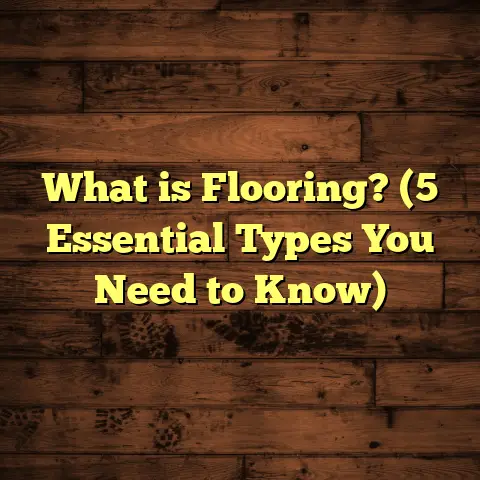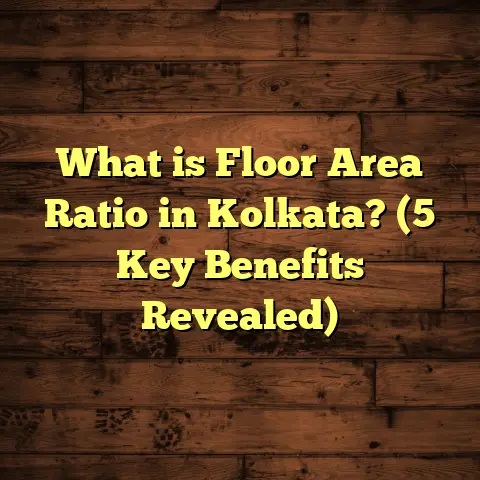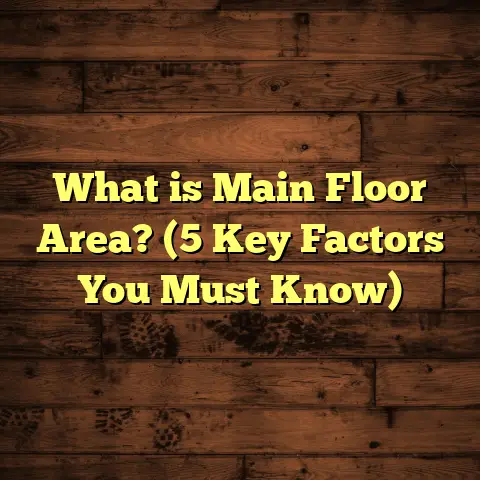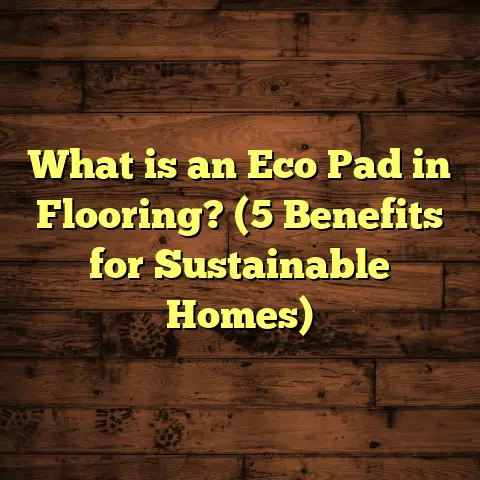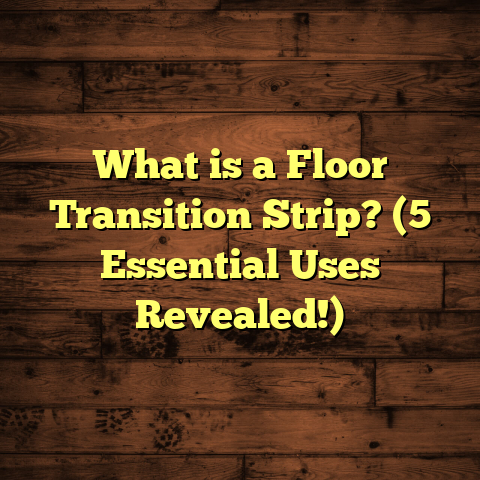What is Better: Vinyl Plank or Laminate Flooring? (5 Key Differences Revealed)
I’ll never forget the day a client called me up, frustrated and unsure. They wanted to redo their entire living room floor but were stuck between vinyl plank and laminate flooring. They said, “I’ve been reading all these reviews, but everyone says something different. Which one should I pick?” If you’re reading this, maybe you’ve felt the same way. Picking the right flooring can be confusing because both vinyl plank and laminate have their own strengths and weaknesses. Over the years, I’ve installed thousands of square feet of both types in homes across different climates and budgets. Let me share what I’ve learned, including some stories from the field and hard data, so you can make a confident decision.
What Is Vinyl Plank and Laminate Flooring? Breaking It Down
Before we jump into differences, let’s clarify what exactly vinyl plank and laminate flooring are. Knowing what you’re working with helps understand why they behave the way they do.
Vinyl Plank Flooring: The Waterproof Wood Lookalike
Vinyl plank flooring is made primarily from polyvinyl chloride (PVC), a type of plastic. The manufacturing process involves layering a base, a photographic film imitating wood grain, and a transparent wear layer on top that protects against scratches and stains. The planks are flexible but sturdy, designed to mimic hardwood floors both visually and texturally.
A key feature of vinyl plank is its waterproof nature. Because it’s plastic-based, water doesn’t seep through or cause damage. This quality has made vinyl plank a favorite for kitchens, bathrooms, basements—anywhere moisture could be an issue.
Vinyl plank products vary widely: some are thin (around 2 to 4mm) and budget-friendly; others are thicker (up to 8mm or more) with enhanced soundproofing and durability features. Prices range from about $2 per square foot for basic vinyl plank to upwards of $7 for luxury lines with embossed textures and beveled edges.
Vinyl plank typically comes with click-lock edges for floating installation or can be glued down for commercial-grade durability.
Laminate Flooring: The Fiberboard-Based Hardwood Mimic
Laminate flooring is a layered product as well, but it’s built around a high-density fiberboard (HDF) core made from wood fibers compressed under heat and pressure. On top of this core lies a photographic layer that realistically mimics hardwood grain patterns or sometimes stone or tile textures. A tough melamine resin wear layer covers it for protection.
Most laminate planks are about 7 to 12mm thick — thicker than many vinyl planks — giving a solid feel underfoot. However, while laminate is moisture-resistant to some extent, it’s not waterproof. Water exposure can cause the fiberboard to swell or warp.
Laminate flooring also uses a click-lock system for floating installation and generally costs between $1.50 to $3 per square foot for materials. Installation costs vary but are usually similar to vinyl plank.
Why I Find This Comparison Interesting
In my experience installing both types in homes from humid Florida to snowy Minnesota, I’ve noticed that choosing between vinyl plank and laminate isn’t just about price or looks—it’s about understanding how each will perform in your specific situation.
For example, in a family with playful kids and pets, durability and scratch resistance might be key. In a high-humidity basement, water resistance will dominate the decision. And budget constraints can sway choices too.
Let’s explore five key differences that will help you decide which flooring fits your needs best.
1. Water Resistance: Who Wins When Spills Happen?
If you’re like me, you want flooring that won’t panic when the occasional glass tips over or when rainy boots come in. Water resistance is often the dealbreaker between these two flooring types.
Vinyl Plank: Almost Impervious to Water
Vinyl plank is made from PVC plastic, making it naturally waterproof. This means water pools on top won’t seep through seams or damage the plank itself. It’s common for vinyl plank floors to be installed in bathrooms, kitchens, laundry rooms, even basements without worry.
To give you some numbers from manufacturers’ specs: many vinyl plank products boast 100% waterproof ratings. Some brands even offer warranties that cover water damage for up to 25 years residential use.
Laminate: Resistant but Not Waterproof
Laminate flooring has a fiberboard core vulnerable to water damage. If water seeps into the seams or sits on the surface too long, the core can swell and warp. According to industry tests, laminate planks can tolerate moisture exposure for roughly 24 to 48 hours before damage begins.
Some newer waterproof laminate products exist (using special coatings and cores) but they usually cost more—often $4+ per square foot—and aren’t as widely available as vinyl plank options.
Real-Life Experience: Basement Battle in Seattle
A few years back, I installed both flooring types in different rooms of a client’s Seattle home. The basement had a minor flooding incident after heavy rains—water pooled overnight on both floors before cleanup.
The laminate portion swelled slightly at the edges after 48 hours of exposure and needed partial replacement. The vinyl plank section was completely unaffected.
This experience reinforced my advice: if moisture is a concern—even occasional—vinyl plank is safer and more reliable.
2. Appearance & Texture: Which Feels More Like Real Wood?
You want your floor to look great—sometimes it’s the centerpiece of your room design. So how do these two compare visually?
Vinyl Plank: Texture That Tricks Your Hand
High-quality vinyl plank flooring often comes embossed with textured wood grain patterns that you can feel underfoot. Some even have beveled edges mimicking real hardwood boards.
The photographic layers underneath are printed with multiple colors and depths to add richness and realism. Because of this texture layering combined with plastic flexibility, many people find vinyl planks look surprisingly like real wood.
Premium vinyl plank collections can cost $3-$7 per square foot but often offer the most convincing wood look and feel on the market today.
Laminate: High-Resolution Images but Flatter Texture
Laminate relies heavily on photographic images printed on paper layers. Early versions looked flat and artificial because embossing technology was limited.
Modern laminates have improved embossing techniques adding texture that feels more natural but generally remains less tactile than vinyl plank’s plastic surface.
Laminate often has a glossier finish compared to vinyl’s matte appearance—which some people like for brightness but others find less authentic.
My Personal Take on Looks
In my work with interior designers and homeowners who care deeply about aesthetics, I find vinyl plank usually edges out laminate for realism—especially in mid-to-high-end lines.
But if budget is tight and you want decent wood visuals at lower cost ($1.50–$3/sq ft), laminate still looks good enough for many spaces like guest rooms or offices.
3. Installation: How Hard Is It To Put Down?
Are you planning a DIY install or hiring pros? Knowing how each type goes down helps set expectations on time and hassle.
Vinyl Plank Installation: Fast & Forgiving
Many vinyl plank products come with click-lock systems allowing floating installation over various subfloors—concrete, plywood, even existing tile or wood floors if flat enough.
Vinyl’s flexibility means minor subfloor imperfections don’t cause big problems. You also don’t need underlayment in many cases, which saves cost and time.
Typically, professional crews install about 250-300 sq ft per day per person for vinyl plank floors, so a 1,000 sq ft room could take 1-2 days to complete with a small team.
Laminate Installation: Requires Careful Subfloor Prep
Laminate also uses click-lock floating installation but demands a very flat and dry subfloor because of its rigid fiberboard core.
Uneven spots can cause planks to crack or separate over time. Underlayment is almost always required to reduce noise and provide moisture barrier protection from below.
Prep work like leveling subfloors can add days to total install time if needed.
Installation speeds are comparable—around 250 sq ft per person per day—but prep complexity often adds effort.
My Experience With DIYers
I’ve seen DIYers struggle more with laminate installation due to subfloor prep demands while vinyl plank tends to be more forgiving for beginners.
If you’re new to flooring installation and want an easier project with fewer risks, vinyl plank is often better suited.
4. Durability & Lifespan: Which Lasts Longer?
Let’s face it—we want our floors to stand up to daily life for many years without losing their charm or function.
Vinyl Plank Durability: Scratch & Stain Resistant
Vinyl plank’s plastic makeup makes it highly resistant to scrapes, dents from dropped objects, pet claws, and stains from spills.
The wear layer thickness varies—typically between 6 mil (light residential use) up to 20 mil+ (commercial-grade). Thicker wear layers translate directly into longer lifespan and better protection against heavy foot traffic.
Most manufacturers offer warranties of 10-25 years residentially depending on product class.
Laminate Durability: Scratch Resistant But Sensitive To Moisture
Laminate flooring’s melamine wear layer offers good scratch resistance—often rated Class AC3 or higher meaning suitable for residential use including kitchens and hallways.
However, once moisture penetrates the core layer or heavy impacts cause chips on edges, repairs are difficult or impossible without replacing whole planks.
Laminate warranties range from 15-30 years depending on quality but water damage voids many guarantees.
Which Holds Up Best in Real Homes?
In homes I’ve worked on with kids and dogs, vinyl plank tends to maintain condition longer because it resists moisture accidents without warping or swelling.
Laminate performs well in dry areas but shows wear faster under high humidity or water exposure conditions.
5. Cost Comparison: What Will You Spend?
Budget is often king when choosing flooring materials. Let’s break down expected costs including materials and installation based on national averages as of 2024.
| Flooring Type | Material Cost (per sq ft) | Installation Cost (per sq ft) | Total Cost for 1,000 sq ft |
|---|---|---|---|
| Vinyl Plank | $2 – $7 | $2 – $5 | $4,000 – $12,000 |
| Laminate | $1.50 – $3 | $1 – $3 | $2,500 – $6,000 |
Notes:
- Vinyl plank prices vary greatly by thickness and brand; luxury lines with enhanced texture cost more.
- Laminate is usually cheaper material-wise but may require additional subfloor prep costs.
- Installation costs depend on region; urban areas tend toward higher labor rates.
- DIY installation can save money but requires skills and tools.
Hidden Costs You Should Know
Don’t forget potential extra expenses like:
- Subfloor leveling or repair (more common with laminate)
- Underlayment purchase (required for laminate)
- Transition strips between rooms
- Removal of old flooring
- Moisture barriers for concrete slabs
In one recent project in Dallas, a client chose laminate because of budget constraints but had to spend an extra $1,200 on subfloor leveling after uneven concrete was found during install prep—bringing total cost close to vinyl options eventually.
Additional Factors That Might Tip Your Decision
Beyond these five main points, here are other things I consider when advising clients:
Sound Absorption & Comfort
Vinyl plank tends to feel softer underfoot due to its flexibility; it also absorbs sound better which reduces footstep noise in multi-story homes.
Laminate is harder and can sound hollow unless quality underlayment is installed beneath it.
Environmental Impact
Both products are mostly synthetic but vinyl is plastic-based with environmental concerns related to production and disposal.
Laminate uses wood fibers but often contains formaldehyde resins (though modern products have reduced emissions).
If eco-friendliness matters most to you, consider natural hardwood or engineered wood alternatives instead of either synthetic floor covering.
Resale Value & Market Preferences
Some real estate agents report that buyers prefer hardwood floors most—but among alternatives vinyl plank shows growing popularity due to durability.
Laminate still attracts budget-conscious buyers but could be perceived as lower-end compared to luxury vinyl options that visually mimic hardwood better.
Wrapping It Up With My Flooring Wisdom
After installing thousands of square feet of both vinyl plank and laminate over two decades…
- If water exposure is a risk anywhere in your home—choose vinyl plank.
- If budget is tight and you want decent looks in dry areas—laminate works fine.
- For ease of installation especially DIY—vinyl tends to be more forgiving.
- For realism in texture and overall durability—high-end vinyl plank beats laminate.
- For scratch resistance especially with kids/pets—vinyl wins again.
At the end of the day, knowing your home environment, budget limits, and lifestyle needs helps pick the right floor—not just the shiny photo on the box.
If you want personalized advice based on your specific project details (location, room size, climate), just ask—I’m happy to help!
Appendix: Case Study From My Recent Projects
Project: Renovation in Orlando family home
Flooring choice: Vinyl plank in kitchen/laundry; laminate in upstairs bedrooms
Why: High humidity and water risk downstairs favored vinyl; upstairs dry areas suited laminate
Cost:
- Vinyl plank material + install: approx $7,200 for 600 sq ft
- Laminate material + install: approx $2,400 for 400 sq ft
Outcome: Over 18 months no damage observed; family loves the mix of durability downstairs + budget savings upstairs
If you’ve read this far—thanks for sticking with me! Choosing between vinyl plank and laminate flooring isn’t always simple but now you have detailed info from someone who’s been there many times before. Your floors will thank you for making an informed choice that fits your home perfectly.
Feel free to reach out if you want me to help crunch numbers or explore specific products available near you!
[End of Article]
